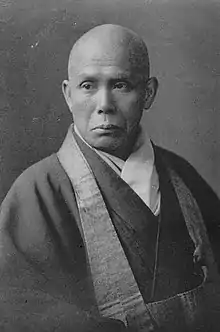Soyen Shaku | |
|---|---|
 | |
| Title | Zen Master |
| Personal | |
| Born | January 10, 1860 |
| Died | October 29, 1919 (aged 59) |
| Religion | Buddhism |
| Nationality | Japanese |
| School | Rinzai |
| Senior posting | |
| Predecessor | Imakita Kōsen |
| Successor | Tetsuo Sōkatsu |
Soyen Shaku (釈 宗演, January 10, 1860 – October 29, 1919; written in modern Japanese Shaku Sōen or Kōgaku Shaku Sōen) was the first Zen Buddhist master to teach in the United States. He was a rōshi of the Rinzai school and was abbot of both Kenchō-ji and Engaku-ji temples in Kamakura, Japan. Soyen was a disciple of Imakita Kosen.
Biography
Soyen Shaku was a Zen monk. He studied for three years at Keio University.[1] In his youth, his master, Kosen, and others had recognized him to be naturally advantaged. He received dharma transmission from Kosen at age 25, and subsequently became the superior overseer of religious teaching at the Educational Bureau, and patriarch of Engaku temple at Kamakura.[2] In 1887, Shaku traveled to Ceylon to study Pali and Theravada Buddhism and lived the wandering life of the bhikkhu for three years.[2] Upon his return to Japan in 1890, he taught at the Nagata Zendo. In 1892, upon Kosen's death, Shaku became Zen master of Engaku-ji.[3]
In 1893 Shaku was one of four priests and two laymen, representing Rinzai Zen, Jōdo Shinshū, Nichiren, Tendai, and Esoteric schools,[4] comprising the Japanese delegation that participated in the World Parliament of Religions in Chicago, organized by John Henry Barrows and Paul Carus. He had prepared a speech in Japan, and had it translated into English by his (then young and unknown) student D. T. Suzuki. It was read to the conference by Barrows. The subject was "The Law of Cause and Effect, as Taught by Buddha". Subsequently, Shaku delivered "Arbitration Instead of War".[5]
At this conference he met Paul Carus, a publisher from Open Court Publishing Company in La Salle, Illinois. Before Shaku returned to Japan, Carus asked him to send an English-speaker knowledgeable about Zen Buddhism to the United States. Shaku, upon returning to Japan asked his student and Tokyo University scholar D. T. Suzuki to go to the United States, where he would eventually become the leading academic on Zen Buddhism in the West, and translator for Carus's publishing company.[6]
Shaku served as a chaplain to the Japanese army during the Russo-Japanese War. He lectured soldiers about how to face their own deaths with unwavering equanimity, stating that they had to defeat not only their external enemies, but also their inner enemies, which he called "demons of the mind" (心魔, shinma).[7] In 1904, the Russian author Leo Tolstoy invited him to join in denouncing the war, but Shaku refused, concluding that "...sometimes killing and war becomes necessary to defend the values and harmony of any innocent country, race or individual." (quoted in Victoria, 1997) After the war, he attributed Japan's victory to its samurai culture.
In 1905, he returned to America as a guest of Ida Russell and her husband, businessman Alexander Russell. He spent nine months at their isolated oceanside house on the Great Highway in San Francisco,[8] teaching the entire household Zen. Mrs. Russell was the first American to study koans. Shortly after arriving, Shaku was joined by his student Nyogen Senzaki.[9] During this time he also gave lectures, some to Japanese immigrants and some translated by D. T. Suzuki for English-speaking audiences, around California.[10] Following a March 1906 train trip across the United States, giving talks on Mahayana translated by Suzuki, Shaku returned to Japan via Europe, India and Ceylon.[11]
Soyen Shaku died on 29 October 1919 in Kamakura.
Dharma heirs
Selected works (in English)
See also
References
- ↑ Ford, James Ishmael (2006). Zen Master Who?. Wisdom Publications. p. 62. ISBN 0-86171-509-8.
- 1 2 Fields 1992, pg. 110
- ↑ Fields 1992, pg. 111
- ↑ Fields 1992, pg. 124
- ↑ Fields 1992, pp. 126-7
- ↑ Fields 1992, pg. 128
- ↑ Micah Auerback, A Closer Look to Zen at War, quoted in Heine and Wright 2010, pg. 160
- ↑ "Architectural and Historical Resources of the Sunset District: The Oceanside Neighborhood". ousidelands.org. Retrieved 9 April 2022.
- ↑ Fields 1992, pp. 168-170
- ↑ Fields 1992, pg. 172
- ↑ Fields 1992, pp. 172-4
- ↑ Ningen Zen Home Archived 2013-03-16 at the Wayback Machine
Further reading
- Fields, Rick. How the Swans Came to the Lake: A Narrative History of Buddhism in America (1992) Shambhala Publications. ISBN 0-87773-631-6
- Mohr, Michel. The Use of Traps and Snares: Shaku Sōen Revisited (2010). In Zen Masters, eds. Steven Heine, and Dale Stuart Wright, 183–216. Oxford University Press. ISBN 9780195367645
- Victoria, Brian (1997). Zen at War. Weatherhill. ISBN 0-8348-0405-0.
External links
- Shaku Soyen: Arbitration Instead of War Comments from the World Parliament of Religion, September 1893
- Thompson, John M. (2005), Particular and universal: the problems posed by Shaku Soen's "Zen" (PDF)
- Works by or about Soyen Shaku at Internet Archive
- Works by Soyen Shaku at LibriVox (public domain audiobooks)
